
|
You will do this whole process three times. |
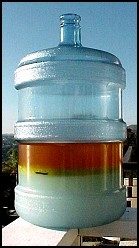
|
|
The crystalline properties removed serve no benefit to the artist. Dry dust crystals happened in a month to linseed/flax oil painted on my van's windshield. Linseed/flax oil by itself has no adhesion properties. Stand oil did well on the glass. I hope this sun dried linseed/flax oil proves well. Theophilus Presbyter, the monk of Paderborn, (1200 A/D) wrote on oils and pigments, he knew back then that cold pressed linseed/flax oil was good... He said the best flaxseed oil was from the Baltic Sea area, and freezing oil and snow together for a week was a great purifier, than sun drying the oil in a shallow lead container 1/2" high, covered with glass, for long enough for the oil to become thick as honey. Cennini called this the best of all oils. This final washed linseed product is less viscous then when you started. |
| Original Raw cold pressed Flax seed linseed oil is mixed with pure warm water and shaken. The mucilage, water and oil separate like Italian salad dressing in distinct layers after 12-24 hours of sitting in a covered jar. The longer you let it set the more oil you reclaim. It is then frozen. The oil can then be poured off the resulting ice containing the frozen mucilage. This is repeated until the desired clarity is achieved (3 times) then sun dry it for at least 3 days. |

|
You will do this whole process three times. |

|
Photos Washing linseed oil or more correctly called flax oil. |
|
Instead of freezing my washings, I let them set until they were clear and syphoned the clear oil out.
|
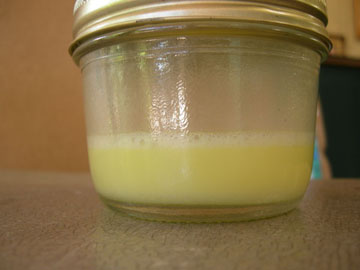
Day1, 6-20-7. batch1, right after shaking it well. |
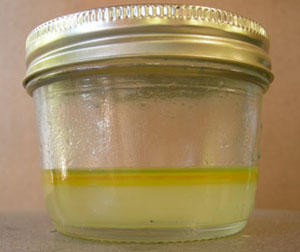
18 hours later, count the rings. |
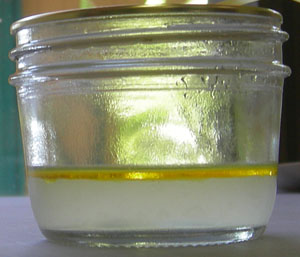
Day 4 of Batch #1. Shows the top green layer, the middle oil layer and the crystalline liquid below. |
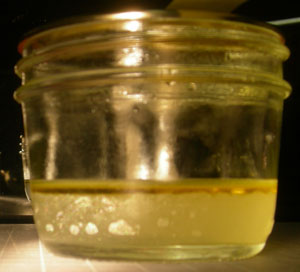
That night I photographed it with a spot light to show the crystals forming in the sludge. |

I shook this batch with a blender, it did the job I could never do by shaking.
|
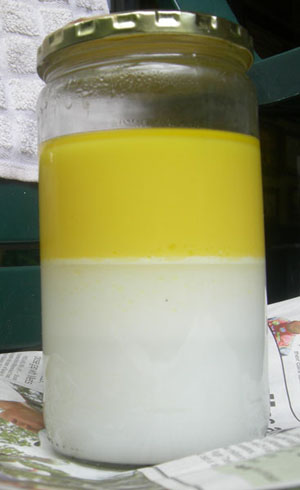
This is 24 hours later. I see the top
|
| I poured off the oil and saved the water sludge with the oil I missed. They are these images. Later I learned to syphoned out only the clear oil to continue with another washing. The washing with the blender has a denser sludge. This sludge was still very opaque on 8-9-7. I think one short wash with a blender equals much more then 3 complete washing by only shaking it a lot.. |
|
This night I was shining a bright light into the sludge of the first batch that already had as much oil removed by pouring as I could, and I saw bright points of light and a large reflecting surface of a transparent crystal. Reflective crystals forming in the water. By shinning a 3 bulb LED light at night into the sludge looked like a black opal without the color. These attached points of light are mighty small, the largest was a pin point of bright light. These crystals were 8 hours old. My night picture didn't focus on sparkles so was useless. 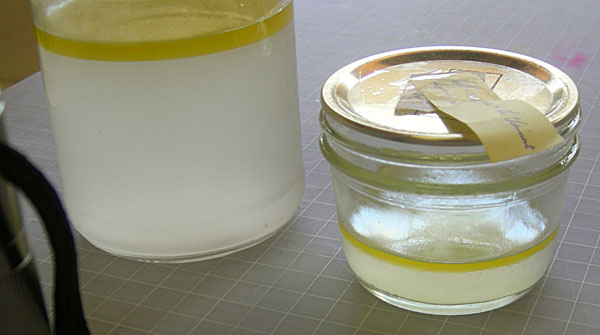 batch#3, is on the left, linseed oil and a lot more water. Oil that was left with the sludge is still in Batch#1 on the right. There are three layers, The top is green, the oil is clear yellow and the water is still settling and dispelling oil and air. 4th day second batch update
|
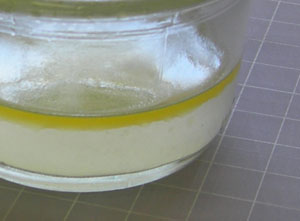
08day4batch1crystalscrop.tif shows the irregular sludge line. |
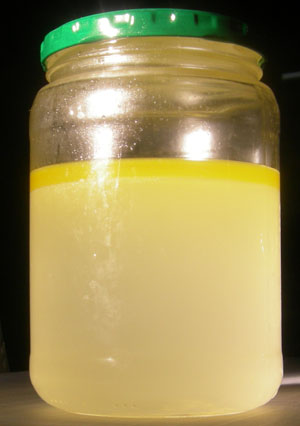
|
| I can see the crystals formed in the water, they seem to be square or pentagon shaped. I shot more night pictures. This large facet of a crystal I saw in the depths of the sludge. I think it was the collapsing (by movement) of these larger crystals that causes the uneven oil and sludge line. |
|
|
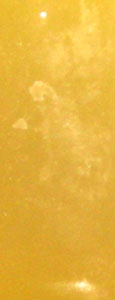
|
Showing two points of light
Mud, clay and basalt
|
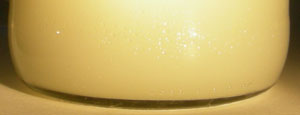
Look at the sparkling crystals above. This sludge is loaded with hard crystals
|
|
|
|
|
Batch#4 is still dense while Batch#1 is clear. This photo was taken on 7-28-7 Look at the three layers in Batch#1, The crumbled crystals, the clear water and the oil that was left on top. |
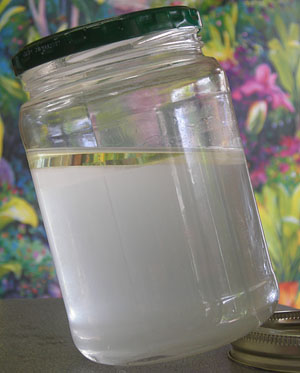 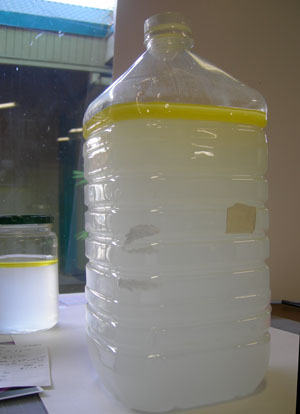
|
| Batch #3 is settled and ready to be syphoned. | Batch #6 after five hours of settling. |
|
Flax oil by itself has very little binding power. Sun thickened linseed oil is sticky, they both have different painting qualities, combine them both in your painting media.
See what else will be added to and for what reasons? Oil Media Tables |
|
Nine crystal filled washing bottles of sludge water. |
|
This is my last settling which includes all the oil. 7-14-7.
|
7-10-7, Today I am putting as much oil into one container as I can and am letting it settle. All but batch1, I want to see how thick crystals will form if left standing. From past medium testing I know I like a 50:50 mixture of sun dried and natural linseed oil. So.. I will sun dry half of the oil and let the other half be. How long will it take batch6 to clear before I sun dry it?
|
|
|
This photo shows collapsed lime crystals. At one time, after making this batch of lime water and letting it sit for outside for six months the crystals, were big and delicate. I had to move it finally and they collapsed into this pile. Another 6 months passed before this picture was taken, no new crystals formed. That might be because it was kept in the dark, but I'm not sure. | I want to test both the washed and sundried washed on my windshield in the sun. Stand oil was uniformly clear after a month the linseed oil crumbled. Water soluble crystals should definatly be removed. These crystals remind me of the crystals formed in setting fresco lime water which also should not be used. Their smooth facets would weaken the lime bond, Clear limewater can be poured off and used instead. |
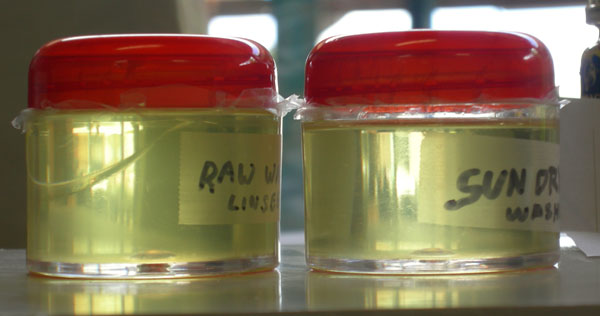 Well this is what I got for testing from 6-20-7 to 7-23-7.
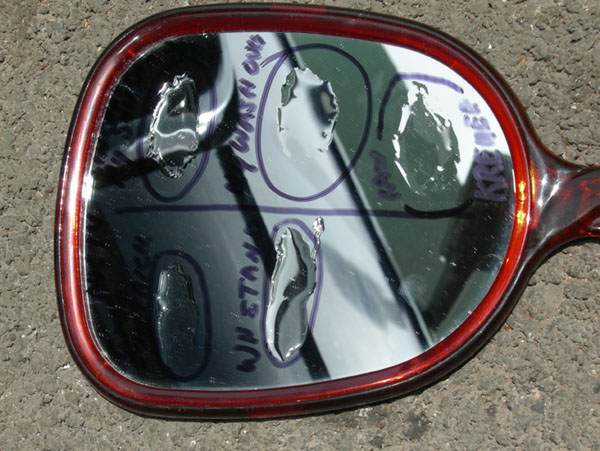 While putting the oils on the glass mirror I decided the sun dried washed linseed oil was thick enough as is. This test was started on 8-14-7, the W/N stand oil was the thickest, Grumbacher Sun Thickened oil was the darkest oil, Kramer flax-linseed oil was the base oil. Well... I put the mirror on top of my van, flat, so it wouldn't run... and forgot it. |
|
7-8-7, day35, I found syphoning out the sludge works best, next to freezing it. Batch6, After 3 complete washings I'm still getting a lot of crystalizing sludge in this new batch. The third washing of the small tests did show a decrease in the sludge. That may also be the case of this combined large batch. I won't know for sure until this large batch settles and I get to make a forth shaking with clear water. 7-9-7, day36, Batch6, The oil is still translucent, the sludge is dense. The thin third level down in the first few washings is now increased in density and sticks to the sides of the jar when tilted. 7-10-7, day 37, The sludge has crystals growing that completely cover the glass. The white opaque layer above the sludge has smooth shapes in it when tilted, the edges are stuck to the glass like the crystals in the sludge do. The interior of it moves as a mass above the sludge layer and is thicker then the oil. The top uppermost "green layer" is still there, but now it's opaque white. I don't know how to get rid of that yet. There is no doubt now, the crystals that formed on the glass are still growing in thickness as a mass. At first I thought the crystals were transparent and the sludge was translucent. However, after a month of settling the sludge is clear and the sticking crystals are translucent. The liquid crystalline compound looks like clear water but I'm still calling it sludge, even though all the crystals in the sludge are now collapsed or attached to the container. This water is as clear as lime water and both make potentially harmful crystals for their media. Both can be settled although I haven't found a use for the oil washed water, the lime water is perfect for painting with, minus the crystals.
7-18-8, Photo of cleaned oil sitting on water filled with crystals holding it's shape while the tilted glass shows the oil moving independently above it. The next step as far as I'm concerned is getting the yellow out of the flax oil. It was written in the 16th century that Valisquise and fellow artists used the lavender plant to do this, along with brandy. That would have been alcohol. Brandy would have added yellow which I'm trying to get rid of. Today I went to the largest lavender farm in Hawaii to get samples to try out. I'll post he lavender and oil results here but the photos of the lavender plant flowers are here. Lavender Plant photos 7-18-8, All those tests with just oil and lavender did nothing. I removed the oil and am washing it in plain water mixed in a blender. photo I found that by mixing: oil, lavender and isopropyl alcohol that it defiantly separated the mucilage with a hard line, it was contained in a bubble with the lavender below the oil. The down side is that the oil was darker yellow brown. Mixing oil and lavender with white rum turned the oil a red brown. I'm not going down those roads. need photo I'm beginning to be concerned about the Gamlin linseed oil, it's a lot darker then the Kermer's best, I can live with that.. The problem is the washing and settling speed. Sometimes these tests take awhile... this one took six years and six months. It just sat at the end of my table until I got around to it. The oil reduced and got heavier until it started to sink. That's when I took this photo. I won't say the oil is done for, I never tried air dried linseed before. Look at the bottom of the jug, those are the heaviest particles of the sludge, I had never seen that before either. I did use the linseed-flax oil to blacken my cast iron pan by brushing it on and placing the pan on a burner until it polymerized completely and turned a shiny, non-stick black. The linseed oil had the sun dried quality of drying fast, I'll say that much for it. 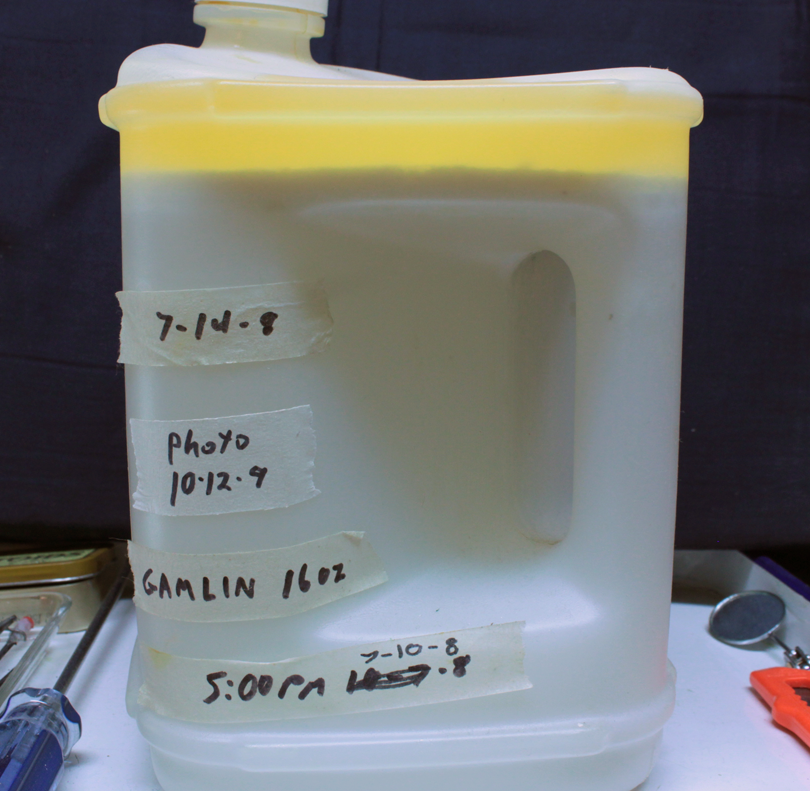 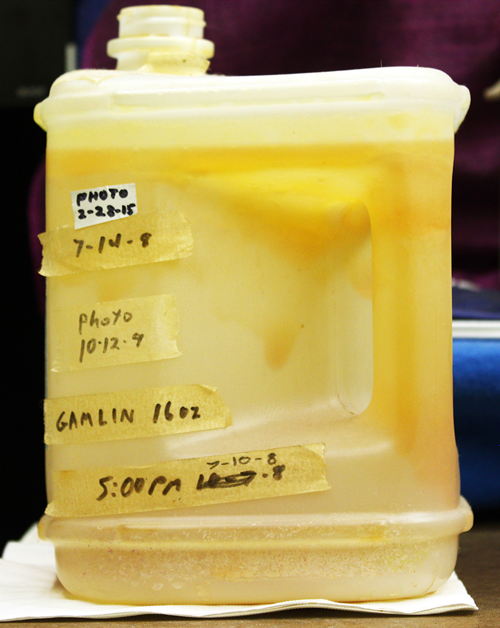 Jaap Posthuma de Boer 6-15-15, wrote, Hi jacob here, I am a French polisher. I put cold pressed linseed oil in a pan of softly boiling water for 2 hours or so, cool, syphoned off the oil and let it stand for 24 hours. White protein settles on the bottom, separate and heat, add beeswax and you have good quality linseed oil wax. Still on the lookout for strong natural varnish. Kind regards Jacob Don: I hope you don't get two of these Jacob.. What you wrote sounds good to me, I'll put it on the site, Hi Don yes I will do that and let you know, I buy my clean oils from Allbäck, now I suspect you have heard of them, Swedish company.
Thanks for replying, nice to know I am not the only person interested in linseed oil.
Thank you Jacob, I would do it but I'm just trying to keep my head above water now. Keep me up to date will you? Test it on any archival paper, date it with a pencil. Do you have a scanner? I have some good washed linseed oil I made in 2008, it's been setting without the water since 2-28-15 and the white protein settled on the bottom, maybe 5%. That reminds me, I have to photo the settled protein in my oil. As a painting medium I would add 2% wax, what percent do you add as a final coat? Maybe none, as you don't need it for painting as I do. Here is the photo of the clear oil and the settled protein (about 2 months) on 6-18-15. I'll try to see if either of the two mixtures will reduce the yellowing.  1 part Stand Oil - 1/4 part Sun Dried Linseed Oil - 1/4 part Cold Pressed Linseed Oil - 1/2 part Venetian - A beautiful balanced paint and glaze. A+ 1 part Stand Oil - 1/2 part Raw Cold Pressed Linseed Oil, - 1/2 part Venetian Balsam - 1/4 part Turpentine - 1/8 part Wax - 2% Drier - Maybe the best medium. A+ 1 part Stand Oil - 1/2 part Sun Dried linseed Oil - 1/2 part Raw Cold Linseed oil - 1/8 part Wax - Add 2% Cobalt Drier to dry in 18 hours or Fifth day light tack. A+ I used this formula for all my 1995 paintings. Sun dried linseed oil settles strokes. Oil Tests 1995 1 part Stand Oil - 3/4 part Sun Thickened Linseed Oil - 1/4 part Raw Cold Pressed Linseed Oil - 1/8 part Turpentine - 1/8 part Wax - 2% drier - No tack, smooth blend, nice. My current medium until I use it up. A+ 1 part Stand Oil - 1 part Sun Thickened Linseed Oil - 1/4 part, Dorland's Wax - Dry in 24 hours. A+ 1 part Sun Dried Linseed Oil - 1 part Cold Pressed Oil - 1/2 part Venetian - 1/4 part Turpentine - 2% Cobalt Drier optional. A+ |
NEXT PAINTING, Pumpkin Patch, Mexico, NY, 2007, pumpkinmexico2007.htm
PREVIOUS PAINTING,
Jacaranda - at the Kula Post Office 2007, jacarandakulapostoffice2007.htm
END PAGE Last Painting w/tips